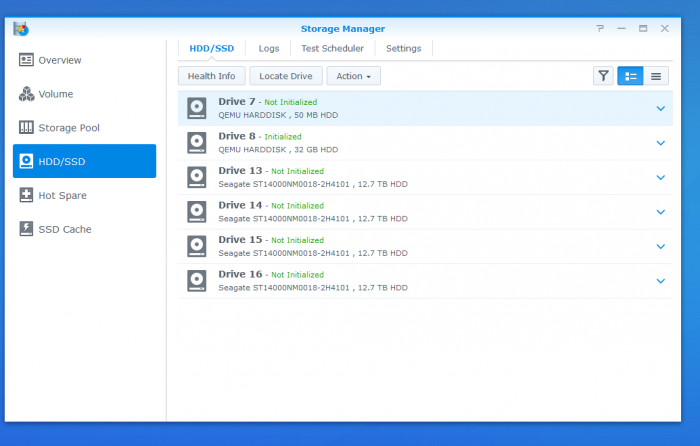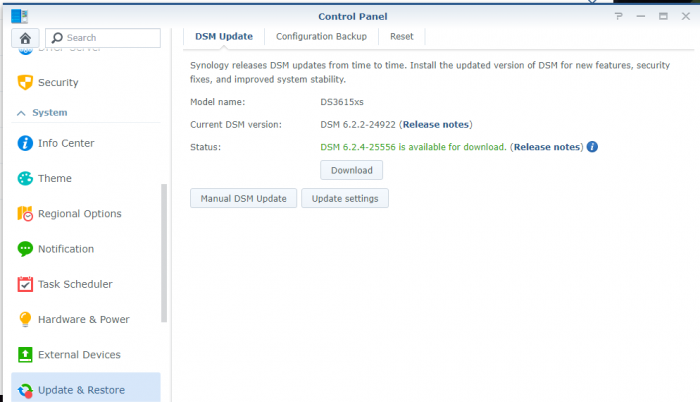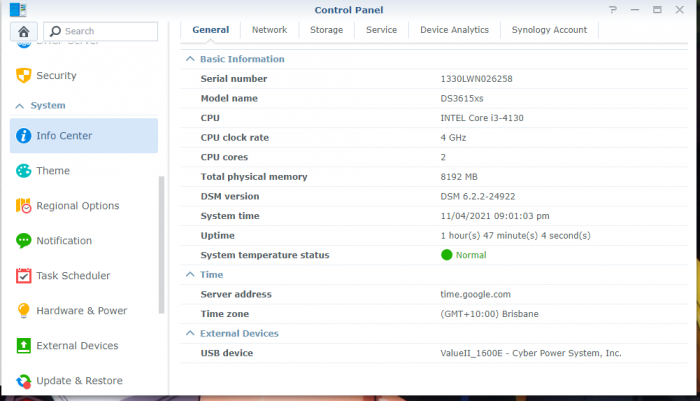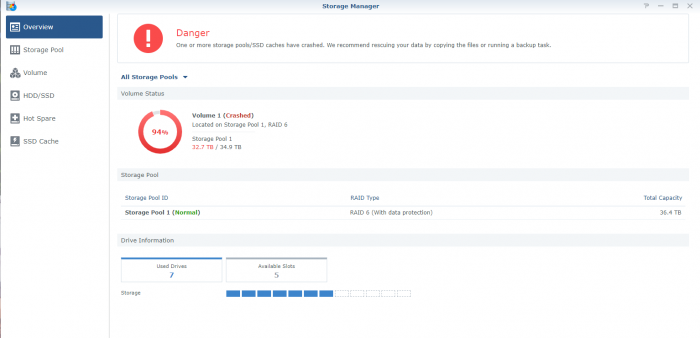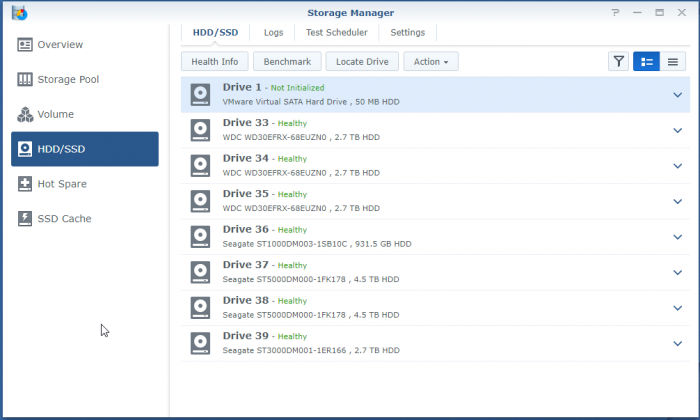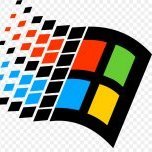Search the Community
Showing results for 'detected that the hard drives'.
-
I have an XPenology 6.x on an old FoxConn D70S-P motherboard with an add-on sata controller for a total of 8 drives. When I replaced one of the older 3TB drives with a new 6TB Seagate ST6000DM003, the pc won't boot. It goes to the 1st screen which shows the add-on controller's SATA drives (4 of them) and then that's it. The fans just spin at full speed and it won't boot. If I put back the older drive, it boots fine. The seagate ST6000DM003 works fine in a usb enclosure. I tried the drive on each of the SATA cables so both on the onboard controller and on the add-on controller, made no difference.
-
Hi, Has anyone managed to integrate Jun's loader into a hard drive? this way you would not need a separate USB stick to boot. I found some instructions here but they are old (for DSM 5.2) and do not work for me. I assume the fundamentals should be the same. A hard drive with 3 partitions bootloader (jun's loader), OS (partition made by DSM) and Data (partition made by DSM) Is this possible? If you have done it, would you please provide instructions? I would like to try it on Vmware (or similar software) to see if it can work. I would appreciate your help.
-
Hi everyone I want to install on my old pc synology, but i see this message https://imgur.com/a/EKcUo0n I have 2 8 tb hdd, and the bios see 2 hdd, but the nas not. I use synoboot_3617d I have another question i want to install dsm 7 its possible? Thanks!
-
Hello everyone, I got my xpenology box almost perfectly running on DSM 5.2. My only problem is, that any USB drive I plug in is shown as an internal hard drive. I changed the synoinfo.conf to support my 25 drive bay. These are my changes : 0000 0000 0000 0000 0000 0000 0000 0000 0000 0000 0000 0x0000 (ESATA) 0000 0000 0000 0000 0001 1111 1111 1111 1111 1111 1111 0x1ffffff (SATA) 0000 0011 1111 1111 1100 0000 0000 0000 0000 0000 0000 0x3ffc000000 (USB) I hope someone can give me a solution for this problem. Best regards Adrian
-
No hard disk is found. Do I need to format the disk first? Using an old disk from an Ubuntu 20.04 server I set up. Just testing the setup before I go buy permanent HDs.
-
hello everyone! I'm a novice. I recently encountered a problem. After repeated tossing, I still can't solve it. I came here to consult an expert! The questions are as follows: Recently, it was found that sata5 and sata6 on the host cannot be recognized after they are connected to the hard disk! Other descriptions: 1. Using USB to do 1.03 boot DSM_ DS3617xs_ twenty-three thousand seven hundred and thirty-nine 2. The motherboard is the AMD platform Biostar t790, which has been connected to four hard disks and uses the interface sata1-4. 3. Grub.cfg file is as follows: if serial --port=0x3F8 --speed=115200;then set has_serial=true terminal_input --append serial terminal_output --append serial else clear fi terminal_input --append console terminal_output --append console if [ x"${grub_platform}" = xefi ]; then insmod efi_gop insmod efi_uga else insmod vbe fi set extra_initrd="extra.lzma" set info="info.txt" set vid=0x***** set pid=0x***** set sn=********8 set mac1=0011******** set rootdev=/dev/md0 set netif_num=1 #set extra_args_3617='earlycon=uart8250,io,0x3f8,115200n8 earlyprintk loglevel=15' set extra_args_3617='' set common_args_3617='syno_hdd_powerup_seq=0 HddHotplug=0 syno_hw_version=DS3617xs vender_format_version=2 console=ttyS0,115200n8 withefi elevator=elevator quiet syno_port_thaw=1' set sata_args='sata_uid=1 sata_pcislot=5 synoboot_satadom=1 DiskIdxMap=0C SataPortMap=1 SasIdxMap=0' set default='0' set timeout='1' set fallback='1' if [ -s $prefix/grubenv ]; then load_env if [ -n "$saved_entry" ]; then set default="${saved_entry}" fi fi VERSION="with Jun's Mod v1.03b" search --file -s /bzImage function savedefault { if [ -s $prefix/grubenv ]; then saved_entry="${chosen}" save_env saved_entry fi } function do_option { if [ $# -lt 2 ]; then eval "set value=\"\$$1\"" echo "current $1: $value"; return; fi set key=$1 shift set $key="$*" if [ -s $prefix/grubenv ]; then save_env $key fi } function vid { do_option vid $@; } function pid { do_option pid $@; } function sn { do_option sn $@; } function mac1 { do_option mac1 $@; } function mac2 { do_option mac2 $@; } function mac3 { do_option mac3 $@; } function mac4 { do_option mac4 $@; } function rootdev { do_option rootdev $@; } function append { do_option extra_args_3617 $@; } function vidpid { if [ $# -lt 2 ]; then echo "usage: vidpid 0xVVVV 0xPPPP"; return; fi set usb_args="vid=$1 pid=$2" if [ -s $prefix/grubenv ]; then save_env usb_args fi } function showtips { if [ -n "$has_serial" ]; then terminal_output --remove serial fi echo "Screen will stop updating shortly, please open http://find.synology.com to continue." echo echo if [ -n "$has_serial" ]; then terminal_output --append serial fi } function loadinitrd { if [ -s $img/$info ]; then if [ -n "$has_serial" ]; then terminal_output --remove serial fi cat $img/$info if [ -n "$has_serial" ]; then terminal_output --append serial fi fi # if [ -s $img/$extra_initrd ]; then # initrd $img/rd.gz $img/$extra_initrd # else # initrd $img/rd.gz # fi } function common_add_option { eval "set value=\"\$$1\"" if [ -z $value ]; then return 1; fi set common_args="$common_args $1=$value" } function common_add_option_ex { eval "set value=\"\$$1\"" if [ -z $value ]; then return 1; fi set common_args="$common_args $2=$value" } function loadlinux { set model=$1 set bootdev=$2 shift 2 if [ -n $vid -a -n $pid ]; then set usb_args="vid=$vid pid=$pid" fi eval "set common_args=\"\$common_args_$model\"" eval "set extra_args=\"\$extra_args_$model\"" eval "set bootdev_args=\"\$${bootdev}_args\"" common_add_option_ex rootdev root common_add_option sn if common_add_option mac1; then set netif_num=1; fi if common_add_option mac2; then set netif_num=2; fi if common_add_option mac3; then set netif_num=3; fi if common_add_option mac4; then set netif_num=4; fi common_add_option netif_num if [ -z $zImage ]; then set zImage=bzImage fi linux $img/$zImage $common_args $bootdev_args $extra_args $@ } menuentry "DS3617xs 6.2 Baremetal $VERSION" --class os { set img= savedefault loadlinux 3617 usb loadinitrd showtips } menuentry "DS3617xs 6.2 Baremetal $VERSION Reinstall" --class os { set img= loadlinux 3617 usb mfg loadinitrd showtips } #menuentry "DS3617xs 6.2 Baremetal AMD $VERSION" --class os { # set img= # set zImage=bzImage # savedefault # loadlinux 3617 usb # loadinitrd # showtips #} menuentry "DS3617xs 6.2 VMWare/ESXI $VERSION" --class os { set img= savedefault loadlinux 3617 sata loadinitrd showtips } Looking forward to the guidance of experts, thank you!
-
As the title says, only 3 of 4 hard drives are found in my ds918+ "bare metal" virtual instance in ESXi 6.7 when connected to an LSI sas9220-8i controller card when using passthrough mode. Before toggling passthrough mode, all 4 drives are seen in ESXi individually. All 4 drives are also seen if I connect them to the motherboard's onboard SATA ports, however passthrough isn't an option with the onboard controller. (drives are setup as RDM) Not sure if anyone else has seen this before. I know the drives are good and I know the LSI controller is good along with the SAS cables. Because I'm passing the drives via the SAS card do I have to adjust my grub.cfg file??? For S&G I tried setting up a virtual ds3615 but I can't get the network working properly so I can't find the machine on my network. (tried vmnet and e1000 emulation) I'm a little perplexed and any assistance is appreciated!
-
I successfully installed xpenology on my new supermicro but it won't read any of the drives. I have an SSD inside that it reads as a storage device but will not read any of the drives in the bays or in the USB ports in the back. I know the drives are good ive checked them in my PC and the server is reading them they spin up and blink and the BIOS show them. So synology isn't recognizing them. Please help. Juns 1.02b 3615 6.1 Drives are Seagate 8tb I also tried a toshiba 1tb This is what I have https://www.ebay.com/itm/173977893894
-
Buon pomeriggio a tutti, sto uscendo pazzo con questo problema: Ho acquistato una vps a 22 euro all'anno (virtualizzazione KVM e software admin virtualizzator) con 20gb ssd ed, avviando dalla iso "XPEnoboot_DS3615xs_5.2-5644.5.iso" va tutto bene, quando vado sul ip della vps esce: "Nessun disco rigido trovato in DS3615xs" ed in basso "Installare i dischi rigidi prima di connettere nuovamente." Help
-
Hi everybody, I hope someone can help me. I previously had a working dsm6.1.7 DS3617xs on an Acer Veriton M460 that works fine, but I need more ram for VM, so I've done an upgrade. I bought a motherboard Gigabyte GA-G41MT-S2PT (rev 2.1) which has a south bridge Intel ICH7 and Gigabit LAN Atheros AR8151. Here the problem began. With a loader 1.02b dsm 6.1.7 it start and seem to be fine, but I can't find the nas on my network. With a loader 1.03b dsm 6.2 it start and i can find nas on my network, but shows up no hard disk found. This motherboard has also IDE ports, i don't know if this can be the cause of my problem. Anyway I've tried to deactivate it, but the bios doesn't allow me to do that. I' ve tried many times with different usb drive (I put correct vid, pid mac and serial on loader anytime). Thanks in advance to anyone
-
I have successfully installed DSM 6.2.3 on my home NAS (booting from USB drive). I have 4 hard drives installed on my NAS: 3 SATA hard drives and 1 SSD. I want to make SSD as my / root file system, so that I can get fast DSM response and the hard drives can sleep longer without wakeup. However, it seems one of my hard drive is mounted as / file system. Is that possible to change that? If so, how to do it? Thanks
-
Hello, I'm totally new in this world. I am trying to install dsm 6.2 on my very old hardware. Actually I decided to make this choice as I would like to try the general performance and calmly buy the whole thing. It has a p5kpl-am mobo and and a core duo. I can start the DHCP if I insert the 1.03 for 3615xs, but in the installation it doesn't see the disks. I have a pci raid controller with a raid 1 configured on it, but even if I connect the hard drives to the mobo eliminating the raid, the installation does not see the hdd, which are 2.5 "Blue 2wd. I'm trying to perform baremetal installation.I also tried the extras, but the dhcp doesn't work anymore either
-
I have the DSM VM setup (DS3615xs DSM v6.2.3-25426-Release-final) in VMWARE Workstaion 15 with mods to the synoinfo.conf file as follows: maxdisks="24" esataportcfg="0xff000" internalportcfg="0xFFFFFF" usbportcfg="0x300000" 24 disk slots are displayed within the Storage Manager overview. I added about 18 VHDs (20GB each) to my VM. The first 12 are shown in Storage Manager and can be included in a volume. The remaining VHDs are listed as ESATA Disks. I'm able to format these designated ESATA drives in File Station but what I'm looking to do is to have them populate in the Storage Manager to be used in volumes. Not sure what I'm missing to get them all populated within Storage Manager as usable drives. Thanks!
-
Intro/Motivation This seems like hard-to-find information, so I thought I'd write up a quick tutorial. I'm running XPEnology as a VM under ESXi, now with a 24-bay Supermicro chassis. The Supermicro world has a lot of similar-but-different options. In particular, I'm running an E5-1225v3 Haswell CPU, with 32GB memory, on a X10SLM+-F motherboard in a 4U chassis using a BPN-SAS2-846EL1 backplane. This means all 24 drives are connected to a single LSI 9211-8i based HBA, flashed to IT mode. That should be enough Google-juice to find everything you need for a similar setup! The various Jun loaders default to 12 drive bays (3615/3617 models), or 16 drive bays (DS918+). This presents a problem when you update, if you increase maxdisks after install--you either have to design your volumes around those numbers, so whole volumes drop off after an update before you re-apply the settings, or just deal with volumes being sliced and checking integrity afterwards. Since my new hardware supports the 4.x kernel, I wanted to use the DS918+ loader, but update the patching so that 24 drive bays was the new default. Here's how. Or, just grab the files attached to the post. Locating extra.lzma/extra2.lzma This tutorial assumes you've messed with the synoboot.img file before. If not, a brief guide on mounting: Install OSFMount "Mount new" button, select synoboot.img On first dialog, "Use entire image file" On main settings dialog, "mount all partitions" radio button under volumes options, uncheck "read-only drive" under mount options Click OK You should know have three new drives mounted. Exactly where will depend on your system, but if you had a C/D drive before, probably E/F/G. The first readable drive has an EFI/grub.cfg file. This is what you usually customize for i.e. serial number. On the second drive, should have a extra.lzma and extra2.lzma file, alongside some other things. Copy these somewhere else. Unpacking, Modifying, Repacking To be honest, I don't know why the patch exists in both of these files. Maybe one is applied during updates, one at normal boot time? I never looked into it. But the patch that's being applied to the max disks count exists in these files. We'll need to unpack them first. Some of these tools exist on macOS, and likely Windows ports, but I just did this on a Linux system. Spin up a VM if you need. On a fresh system you likely won't have lzma or cpio installed, but apt-get should suggest the right packages. Copy extra.lzma to a new, temporary folder. Run: lzma -d extra.lzma cpio -idv < extra In the new ./etc/ directory, you should see: jun.patch rc.modules synoinfo_override.conf Open up jun.patch in the text editor of your choice. Search for maxdisks. There should be two instances--one in the patch delta up top, and one in a larger script below. Change the 16 to a 24. Search for internalportcfg. Again, two instances. Change the 0xffff to 0xffffff for 24. This is a bitmask--more info elsewhere on the forums. Open up synoinfo_override.conf. Change the 16 to a 24, and 0xffff to 0xffffff To repack, in a shell at the root of the extracted files, run: (find . -name modprobe && find . \! -name modprobe) | cpio --owner root:root -oH newc | lzma -8 > ../extra.lzma Not at the resulting file sits one directory up (../extra.lzma). Repeat the same steps for extra2.lzma. Preparing synoboot.img Just copy the updated extra/extra2.lzma files back where they came from, mounted under OSFMount. While you're in there, you might need to update grub.cfg, especially if this is a new install. For the hardware mentioned at the very top of the post, with a single SAS expander providing 24 drives, where synoboot.img is a SATA disk for a VM under ESXi 6.7, I use these sata_args: # for 24-bay sas enclosure on 9211 LSI card (i.e. 24-bay supermicro) set sata_args='DiskIdxMap=181C SataPortMap=1 SasIdxMap=0xfffffff4' Close any explorer windows or text editors, and click dismount all in OSFMount. This image is ready to use. If you're using ESXi and having trouble getting the image to boot, you can attach a network serial port to telnet in and see what's happening at boot time. You'll probably need to disable the ESXi firewall temporarily, or open port 23. It's super useful. Be aware that the 4.x kernel no longer supports extra hardware, so network card will have to be officially supported. (I gave the VM a real network card via hardware passthrough). Attached Files I attached extra.lzma and extra2.lzma to this post. They are both from Jun's Loader 1.04b with the above procedure applied to change default drives from 16 from 24. extra2.lzma extra.lzma
-
After wracking my brain for the New Years weekend and scouring both Xpe and Proxmox forums, I finally got IOMMU pass-through working for my LSI card. (Pay attention to the little details guys!!! The code goes on one line, one line!!!! It isn't delineated line by line. 😩 /rant) Prior to the PT fix, Proxmox was showing all of the 7 drives installed on the LSI PCI card. After pass-through obviously not as the Xpenology VM is accessing. However, upon logging into DSM I'm seeing some weird behavior and I don't even know where to begin so maybe someone has seen this before and can point me in the right direction. [Just as a side note, yes only 7 drives even though hard drive caddy and PCI card can support 8.] As you can see in the picture, drives are listed from 7-16. I am running two ssd's zfsmirror as the boot for Proxmox and image loader for VMs. I have 7 drives of 8 installed on the LSI 9211-8i PCI card. I see 4 of those drives as Drive 13-16. Drive 7 and 8 are the VM sata drives for the boot and loader information. Missing 3 on the other LSI SAS plug [assuming the three missing are all on the second SAS/SATA plug as it makes sense and it is port #2 on the card]. My guess is there is a max capacity of 16 drives in the DSM software. The mobo has a 6sata chipset (+2 NVME PCI/SATA unused), the two boot sata devices [drive 7 and 8] are technically virtual. 6 from the physical sata ports from chipset, +2 virtual sata for boot, +4 [of 8] from the LSI = the 16 spots listed. Is my train of thought on the right track? If so, my next thought then is, how do we block the empty [non-used] sata ports from the Chipset from taking up wasted space on the Xpe-VM? Like I said, I'm stuck. I need a helpful push in the right direction. Space below left for future editing of OP for any requested information.
-
External HDDs detected as internal HDD after synoinfo.conf edit.
Triplex posted a question in General Questions
Please be patient with the newbie here. This is my third xpenology box that I put together in the last 5 months, so I have some experience with editing the synoinfo.conf file, and minimal experience in Linux. This is my very first post. DS918+ running DSM 6.2.3-25426 Update 2 on Jun's 1.04b loader. I love it! :) Everything was working fine after install (including detecting and reading from external HDDs), but it not detect all 10 internal drives were detected. I had this problem before on when using DS3615xs on the same NAS box, and this tutorial worked great! But this time the external HDDs are showing up as internal HDD! Original binary to HEX (with "maxdisks=16"): 11 0000 0000 0000 0000 ==> USB ports = 30000 00 1111 1111 1111 1111 ==> Sata ports = FFFF Modified binary to HEX (with "maxdisks=20") 11 0000 0000 0000 0000 0000 ==> USB ports = 300000 00 1111 1111 1111 1111 1111 ==> Sata ports = FFFFF esataportcfg="0x0" Both synoinfo.conf from /etc and /etc.defaults were edited. dmesg.txt shows 4 USB ports detected, but when I changed the binary to "1111" it also did not detect any USB port. dmesg.txt shows 20 ata ports detected, this is why I have expanded the maxdisks to 20. It sounds cool to be able to use external HD as part of internal volumes, but my data is located in the external HDD, so I cannot bring it back to new volumes. I want to have access to external HDDs to use HyperBackup on a NTFS drive for portability of backups. Hardware: • OptiPlex XE2: Intel Core I7-4770S (4 Cores/8 Threads, 3.10 GHz, Turbo 3.90 GHz), RAM 12Gb 1600 MHz DDR3 Drives #17 and #18 below are two different external HDDs. Any ideas are highly appreciated! Thanks! :) -
As the title suggests when I woke up today my Plex was no longer working so I logged into my DSM and it warns that Volume 1 has crashed. Now this is the only volume I Have which is made up of 7 8TB HDDs, and in Storage pool everything is normal. I can boot the DSM and still access the files locally through the network but seems to be in limp mode. No apps can run within DSM. Other than setting this up initially about a year ago I have no Idea how to use Linux or even using terminal from outside of the NAS. Have never had an issue with this and it bypassed just having normal HDD's fail and straight to oh sorry but your screwed. Any help would be greatly appreciated. Moochin.
-
Hello, sorry for my bad englisch. in the morning i startet with a big mistake. i strated 6.24 to install. it dosent`t work . i know it nowafter a lot of trail , readinfg the forum, i was abel to install 6.1.6. on a ds916+ I fund at least al my drives. then i want to upgrade to 6.2.3. i am use the 1.04 loader and an emty ssd. after the install i had an running 6.2.3 system on a ds 918+ But thenn i wannt to install my data hdds. wenn the system was runnig i connect the hdds with the pc during it runs. i found the drives in storage manager. then i want to restart the system. the system told me that drives from a ds916+ come to a ds918. i would start an migration, chose the pat file witch i am used at last. after 57 % the system told me ,the file maybe damaged.(13) the system has no realy new system datas so i chose new installatin but there was the same problem. what can i do? the system runs before the big mistake whitout anny problems. Dirk
-
Drives showing like this on 6.2.3-25426 update 3 (DS3617xs) This is running Jun's loader 1.03b on EXSI v6.7 update 2 - loading as EXSI (not bare metal) This has FixSynoboot installed and loaded correctly The reason i'm concerned as the Volume 1 is ignoring one of my 3TB HDD's in raid 5, so it's degraded
-
Where does DSM get installed to, the USB stick or hard drives?
gquiring posted a question in General Questions
I am wondering how the DSM product gets installed. I am puzzled because I can build a USB stick that is bootable and is seen by find.synology.com but after I install DSM the stick is no longer seen with find.synology.com. I have to reimage the USB stick to make it seen again. Does anything actually get written to the USB stick during the install process? -
918+ Can Not Create Hot Spare Drives "Operation Failed"
powerplyer posted a question in Answered Questions
Hello, I have the below configuration and getting an error when trying to create two spare drives. I get "The Operation Failed. Please log into DSM again and retry". Needless to say logging in or logging out does not work. Configuration: DSM 6.2.3-25426 Update 3 + 918+ with 0.13.3 extra.lzma/extra2.lzma + Jun 1.04b + MBR [Direct USB] Supermicro X10SAE 14x 10TB SATA HDD 2x 256GB SSD 2x 9211-8i (8 HDD each) 2x SATA from Motherboard Set-Up: Storage Pool - RAID 10 (with 12x 10TB) Volume - One Volume 2x SSD for Cache 2x HDD for HOT SPARE FAILED - Creating a hot spare with above error. I did look at dmsg but did not see any error. I also tried to modify the GRUB file with "SataPortMap=288", but no luck. -
Running bare metal on a gen8 Microserver. I’d like to hide the onboard micro sd card (which shows up / mounts as usb in xpenology ) I have esxi on this microsd which I’ll sometime change the boot order from the ilo to boot esxi .. I’d prefer not these to mount when xpenology boots. (Yes I can eject / up mount the sd, and ignore the drive , but would prefer for it not to show. )
-
Hi, I'am a beginner in the Xpenology world. I chose to start by running it in ESXi, installation and everything else was ok thanks to several tutorials here. But I have two little problems now that i'am using this machine daily. First, when i'am running something pretty heavy on the CPU, like uncompressing huge RAR or ZIP archives, the CPU usage never goes beyond something like 10%.... It's a shame, because I have a 4 cores Intel Core i3... Secondly, when I want to plug a USB hard drive to move files, I can't find it in DSM. I found a tutorial, explaining to add a USB device in the virtual machine settings, but it doesn't appear in DSM... Any ideas? Thanks.
-
Hi Xpenologist, I bought 2x4TB WD Red NAS drives for and added them in my DS3615xs (HP Z800 ) but as I am using MBR version of loader System is telling me each drive is 2TB only. did a little search on this and found that its due to MBR and max size is 2TB only. Any way/workaround to fix this? Thanks and Regards
-
If you own a WD Red NAS SMR drive or plan to buy one you should read this article: https://blocksandfiles.com/2020/04/14/wd-red-nas-drives-shingled-magnetic-recording/ Update: https://blocksandfiles.com/2020/04/24/western-digital-smr-drives-policy-change/


